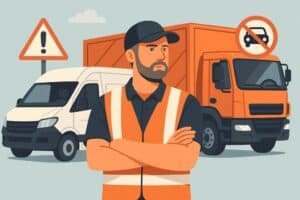So you’re driving for work now, whether that’s a delivery van, a company truck, or even just using your pickup for business purposes? Yeah, this is honestly totally different from just driving your personal car around, and a lot of people don’t realize how much changes when you’re operating a commercial vehicle.
Whether you’re behind the wheel of a big box truck, making deliveries in a van, or driving a company pickup to job sites, operating a commercial vehicle comes with way more responsibility than most people expect when they first start doing it.
These vehicles are often larger and heavier than what you’re used to, and they’re subject to much stricter regulations than personal cars. Plus, accidents involving commercial vehicles can lead to really serious consequences for both you as the driver and the business you work for.
That’s exactly why safety isn’t just a good idea when you’re driving commercially – it’s literally part of your job responsibilities, and both your employer and the law expect you to take it seriously.
What Is Considered a Commercial Vehicle?
A commercial vehicle is any vehicle used for business purposes, especially when you’re transporting goods, passengers, or equipment as part of your job.
This obviously includes large trucks like tractor trailers that everyone thinks of as commercial vehicles, but it also covers smaller vehicles like cargo vans, service pickup trucks, shuttle buses, and even certain SUVs depending on how they’re being used.
Vehicles can get classified as “commercial” based on their weight, how many people they can seat, or how they’re registered and insured with the state and your company.
The key thing is that if you’re using it to make money or as part of business operations, it’s probably considered commercial regardless of what it looks like.
Conduct a Pre-Trip Inspection Every Time
You need to check your tires, lights, brakes, fluid levels, and mirrors before you hit the road every single time you drive. This isn’t just a suggestion – it’s often a legal requirement.
Look for leaks, signs of wear, or anything else that could cause breakdowns or safety hazards while you’re out on the road with cargo or passengers.
Document these inspections if your employer or state regulations require it. This documentation can protect both you and your company if something goes wrong later.
Even if it seems like a hassle when you’re in a hurry, taking ten minutes to check your vehicle can prevent way bigger problems down the road.
Understand Your Vehicle’s Blind Spots
Larger commercial vehicles have massive blind spots on all sides, especially on the right side and directly behind the vehicle. These blind spots are way bigger than what you’re used to in a regular car.
Use your mirrors frequently and be extra cautious when changing lanes or backing up. Don’t assume you can see everything around you like you could in your personal vehicle.
Consider asking your employer about adding backup cameras or proximity sensors if your vehicle doesn’t already have them. These safety features can prevent accidents that cost way more than the equipment.
Remember that if you can’t see other drivers in your mirrors, they probably can’t see you either.
Manage Your Speed and Following Distance
Heavier vehicles need significantly more time and distance to slow down or stop completely. You need to leave way more space between you and the car ahead than you would in a regular car.
Always drive at a speed that’s safe for the current road and weather conditions, regardless of what the posted speed limits say. Just because you legally can go that fast doesn’t mean you should.
Avoid sudden braking or sharp turns, especially when you’re carrying a load that could shift and affect your vehicle’s balance and control.
Commercial vehicles handle differently than personal cars, so you need to adjust your driving style accordingly.
Secure Your Cargo Properly
Loose tools, equipment, or unbalanced cargo can shift around while you’re driving, which can seriously affect your vehicle control or even cause accidents if stuff flies around inside the cab.
Use proper tie-downs, racks, or containers that meet DOT standards or whatever requirements your company has for securing cargo safely.
Overloaded vehicles are much harder to control and way more prone to tire blowouts or brake failures that can cause serious accidents.
Take the time to secure everything properly before you start driving, even if it seems like a short trip where nothing could go wrong.
Conclusion
When you’re driving a commercial vehicle, you’re representing a business and that honestly comes with much higher standards for safety and professional responsibility than just driving your own car around.
By understanding what qualifies as a commercial vehicle and practicing smart, consistent safety habits every time you get behind the wheel, you can protect yourself, your cargo, and everyone else sharing the road with you while also protecting your job and your company’s reputation.







